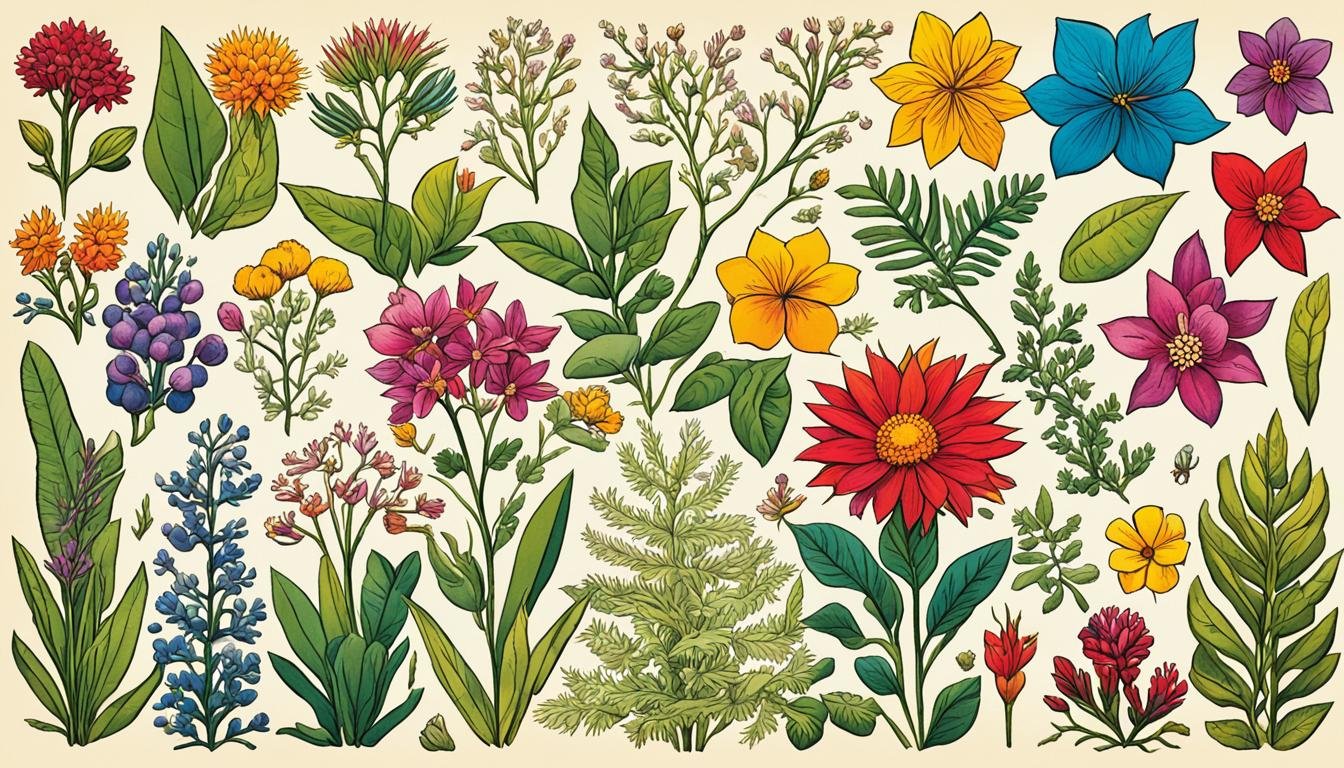There were about 1,000 plant kinds in the Philippines. Father Manuel Blanco, a Spanish botanist, recorded them all in “Flora de Filipinas.” He started this work when he got to the Philippines in 1805. Blanco was amazed by the variety of plants he saw and decided to gather details. His work became the first big book on the region’s plants. It was a big step in learning and saving the Philippines’ natural treasures.
Key Takeaways:
- Father Manuel Blanco, a Spanish botanist and Augustinian friar, was the first to extensively study and document the native plants of the Philippines.
- Blanco’s pioneering work, “Flora de Filipinas,” described over 1,000 plant species found in the Philippines, making it a landmark in the study of the country’s botanical wealth.
- Blanco’s work inspired future generations of botanists and scholars to further explore and preserve the Philippines’ unique plant life.
- The grand folio edition of “Flora de Filipinas” featured 477 beautifully detailed color lithographic plates, showcasing the artistic talent involved in the project.
- Blanco’s legacy continues to be celebrated and promoted, with recent collaborations to preserve and share his botanical masterpiece with the world.
Introduction to Father Manuel Blanco
Father Manuel Blanco was an Augustinian from Spain. His passion was studying the plants in the Philippines. He was born in Navianos, Zamora on November 24, 1778. Blanco joined the Augustinian order when he was only 16. In 1804, he left for the Philippines as a missionary.
Early Life and Calling
In his early years as a friar, Blanco began to love the natural world. At a young age, he chose to go to the Philippines as a missionary. This decision greatly influenced his future work as a botanist in the Philippines.
Arrival in the Philippines as a Missionary
Once Blanco reached the Philippines, he was sent to Angat in Bulacan. He quickly learned to speak Tagalog. This skill helped him talk to the locals and learn about the plants around him.
His time in the Philippines allowed him to deeply dive into documenting the plant life. His work laid the foundation for his famous book, the Flora de Filipinas.
Blanco’s Passion for Philippine Flora
Father Manuel Blanco was on a mission. His goal was to find natural remedies from the Philippine plants. He wanted to help the people in his church. Blanco taught himself a lot about plants. He was especially interested in the variety of plant life in the Philippine archipelago. He learned from the famous Swedish botanist, Carolus Linnaeus.
Discovering Natural Remedies
Blanco was really into studying the Philippine flora. He wanted to find new natural remedies for his parishioners. He carefully watched and took notes on how plants could be used for medicine and healing. Blanco traveled all over the archipelago, looking at different plants.
Mastering Tagalog and Exploring the Archipelago
In Angat, Bulacan, Blanco learned Tagalog. This helped him talk to local people and really get to know their traditional plants. Being able to speak Tagalog well, along with his island explorations, let him deeply explore botanical studies of the area.
The Birth of “Flora de Filipinas”
Blanco, having taught himself, studied the plants of the Philippines closely. In 1837, he made a big step by publishing the first Flora de Filipinas. This book described 903 types of plants, with 31 in their natural names. It was printed by the University of Santo Tomas in Manila.
Self-Taught Botanical Studies
Blanco didn’t have formal training in botany. However, his love for figuring out the Flora de Filipinas pushed him to learn. He used the knowledge of famous botanists like Carolus Linnaeus to better understand the plants in the Philippines.
First Edition in 1837
In 1837, Blanco released the first Flora de Filipinas. This was a major achievement. His work, documenting over 1,000 plant species, set a strong foundation for studying the Philippines’ flora. It became a go-to source for botanists and researchers thanks to the detailed descriptions.

Father Blanco
Father Manuel Blanco spent his life studying the Philippines’ plants. As part of the Augustinian friars, he journeyed across the islands. He learned the local languages and dived deep into the natural world. Blanco wrote the first full book on the country’s plants, called “Flora de Filipinas.” This book was a big step in knowing more about the Philippines’ plant life.
Blanco stayed in the Philippines for 40 years. He gathered 1,200 plant samples, carefully noting what each one looked like and their uses. His work, with his language skills and love for nature, really helped in studying the plants in the Philippines.
“Flora de Filipinas” came out in 1837. Blanco updated it with a second edition, but he passed away in 1845. His masterpiece inspired many to explore, learn, and safeguard the Philippines’ special plants. He is still remembered as a key figure in the research on the country’s plants, known for his work as an Augustinian Friar in Botanical Studies and Philippine flora.
Subsequent Editions and Illustrations
After the first release of Flora de Filipinas in 1837, Father Manuel Blanco kept working on it. He added more plant details to his work on the Philippines. The second edition, out just before Blanco passed in 1845, had even more plant descriptions. It completed Blanco’s detailed guide to the Flora de Filipinas.
Grand Folio Edition with Colored Lithographs
In the end, the third and most impressive edition of Flora de Filipinas was published. This edition came out between 1877 and 1883. It showed over 1,000 plant types with 477 awesome color lithographic plates. This was the first time such a detailed book on the Philippines’ plants had been made, with lovely Botanical Illustrations. The hard work and beauty of the Expanded Editions of Flora de Filipinasmade it a true masterpiece.
| Edition | Year | Descriptions | Colored Plates |
|---|---|---|---|
| First | 1837 | 903 | – |
| Second | 1845 | Expanded | – |
| Third (Grand Folio) | 1877-1883 | Over 1,000 | 477 |
“The meticulous attention to detail and artistry in this Expanded Editions of Flora de Filipinas cemented its status as a true botanical masterpiece.”
In the third edition, the Colored Lithographs showed the talents and hard work of its illustrators. Sadly, the plates were all lost. There were only 600 copies of each plate made before they were gone forever.

Challenges and Setbacks
Even though Father Manuel Blanco worked hard to document the Philippine flora, he faced big challenges. He had very little access to plant specimens from other countries. This made his work have a lot of errors in the botanical nomenclature and plant classification.
This problem made it hard for him to identify and group plants accurately. The vast number of plants in the Philippine archipelago added to this difficulty.
Additionally, the Manila Botanical Garden’s library and its collections were destroyed in various conflicts. These conflicts included the Philippine Revolution of 1896-1898 and the Japanese occupation during World War II.
These losses were huge, as they wiped out Blanco’s carefully built collections. The loss of these collections was a great setback. It affected both the survival of his botanical work and its development over time.
However, Blanco’s beginnings with “Flora de Filipinas” were crucial. His work became a stepping stone for future botanists and researchers. They were inspired by his legacy to dig deeper into the diverse plant life of the Philippines.
Blanco’s Legacy and Impact
Father Manuel Blanco faced many challenges when he started working on the Flora de Filipinas. Despite this, his efforts motivate today’s botanists and scholars. They encourage us to look deeper into the Philippine flora. Blanco’s work laid a strong foundation for studying the variety of plants in the Philippines.
Inspiring Further Philippine Botanical Studies
Blanco’s detailed records about the Philippine flora still inspire botanists and researchers. Many have used his book, the Flora de Filipinas, as an important guide. Thanks to Blanco, studying the unique plant life in the Philippines has become more extensive. His work helps us value and understand the country’s diverse plants.
Recognition and Awards
Blanco’s botanical legacy is also recognized with prestigious awards. The special edition of the Flora de Filipinas from 1883 is a stunning example. It includes detailed information and beautiful color plates of plants. This edition won a top science award in Amsterdam. This award shows how important Blanco’s work is in the world of botanical research.

The Fifth Edition: A Collaborative Effort
In 2017, the Vibal Foundation, Inc., with the help of CSIC and the Real Jardin Botanico in Madrid, released the fifth edition of Flora de Filipinas. Dr. Domingo A. Madulid edited this version, with inputs from Filipino scholars, artists, and Father Ricky Villar, OSA of the Augustinian Order.
Edited by Dr. Domingo A. Madulid
The fifth edition was a group project. Dr. Madulid led the editing, joining forces with the Augustinians of Intramuros and Vibal Foundation. Together, they crafted this in-depth edition.
Contributions from Filipino Scholars and Artists
The fifth edition highlighted Dr. Madulid’s expertise and the work of Filipino scholars and artists. They made vital additions, making sure the book truly reflected the beauty and culture of the Philippine flora and culture.
| Key Highlights of the Fifth Edition | Details |
|---|---|
| Collaborative Work | Edited by Dr. Domingo A. Madulid with contributions from Filipino scholars, artists, and the Augustinian Order |
| Support and Cooperation | Supported by the CSIC and the Real Jardin Botanico in Madrid, and published by the Vibal Foundation, Inc. |
| Illustrations and Botanical Descriptions | Included illustrations on interfacing pages alongside detailed botanical descriptions |
| Selection of Plants | Focused on 150 Philippine plant species, a fraction of the over 1,000 species covered in the third edition |
The fifth edition celebrates the combined work of many. Filipino academics, artists, and the Augustinian Order contributed to highlight the Phillipines’ botanical wealth.
Exploring the Fifth Edition
The fifth edition of “Flora de Filipinas” is all about 150 Philippine plant species. These plants were chosen for how they’re used, how rare they are, and how well-known they are. Dr. Domingo A. Madulid led the work. He used Blanco’s original notes to show how Filipinos trust nature to heal them.
Blanco’s Original Notes and Cultural Context
The fifth edition also talks a lot about the cultural side of these plants. Blanco wrote down many stories and facts about them. His work helps us see how deeply Filipinos care about and depend on the nature around them.
This book is about more than just plants. It looks at how plants are used in medicine and how they’re important culturally. For example, it discusses the nilad plant, which Manila is named after. The book mixes Blanco’s notes with stories about plants. These stories show the special bond between Filipinos and their natural world.
Significant Plant Species
The fifth edition of “Flora de Filipinas” showcases many different plants from the Philippines. It includes both familiar and exotic plants found in the country. Some plants discussed in the book are very important for the history and culture of the Filipino people.
Familiar and Exotic Plants
In this edition, the nilad (Ixora Manila) is highlighted. This flowering shrub gave its name to Manila, the capital of the Philippines. The book also looks at the tungkod-pari, a plant essential in Ifugao rituals. It shows how important some plants are in the cultural traditions of the Philippines.
Plants with Historical and Cultural Significance
The fifth edition of “Flora de Filipinas” not just catalogs the Philippines’ plant life. It also talks about the unique cultural value of many Philippine plants. The book shares about plants with special native names, showing a strong bond between the Filipino people and their environment.

Insights into Filipino Culture and History
“Flora de Filipinas” goes beyond just the plants. It gives us a peek into Filipino culture and history. The book shares how plants were used in traditions and stories. This shows how important they were in daily life and beliefs.
Traditional Uses and Folklore
The fifth edition of “Flora de Filipinas” shares about the uses of plants in the Philippines. It shows how deeply nature and people are connected. For example, it talks about the nilad, a flowering shrub named Ixora Manila. The capital city of Manila got its name from this plant. It also talks about the tungkod-pari, a sacred plant in Ifugao rituals.
Historical Anecdotes and Social Context
“Flora de Filipinas” also tells historical stories that help us understand Filipino culture. For instance, in 1642, the governor general made planting coconut trees mandatory. They did this to feed soldiers and locals. This shows the vital role plants played in the country’s past.
This book offers a deep look into how plants, stories, and history connect. It shows the strong bond between nature and Filipino life and culture.
Blanco’s Masterpiece as a Landmark
“Flora de Filipinas” is known as an botanical masterpiece. It’s praised for both its science and its artistic value in the Philippines. The edition is filled with 477 color plates, showing the plants in detail. This shows the talent of the Filipino and Spanish artists working together. This book is important for art and culture in the Philippines. Many people helped make the fifth edition, including experts and cultural groups.
Artistic and Cultural Value
The artistic value of “Flora de Filipinas” shines through. Its beautiful pictures capture the variety of the Philippines’ plants. The big edition is a true botanical masterpiece. It shows the hard work and care that went into making it. The mix of Filipino and Spanish art highlights the book’s cultural impact.
Significance in Philippine Art and Culture
“Flora de Filipinas” goes beyond science to represent Philippine art and culture. The recent edition was a team effort. It shows how important Blanco’s work is to art and thinking in the Philippines. This book helps us remember the country’s diverse plants and their cultural significance.
The Blanco Family Museum in Angono holds over 400 masterpieces by the Blanco family. This museum honors their skill in realism and their special styles. It shows us the lasting impact of this botanical masterpiece.
Preserving and Promoting Philippine Flora
Blanco’s Flora de Filipinas is a key tool in showcasing the diverse Philippine flora. It highlights the need to protect biodiversity. This book is especially important because many plants here are found nowhere else. Efforts to share Blanco’s work, like the fifth edition, help us understand why we must care for the Philippines’ plants.
Importance of Biodiversity Conservation
The Philippines is rich in plant species unique to its lands. This unique biodiversity is not just interesting; it’s vital for people and nature. Preserving these plants is like protecting a life web. It helps communities, offers resources, and makes our world stronger.
Raising Awareness Through Blanco’s Work
The ongoing effort to share Blanco’s Flora de Filipinas, the fifth edition included, is a big deal for environmental awareness. It makes his detailed work known to more people, helping us see the beauty and importance of the plants he documented. This, in turn, pushes us to keep the Philippines’ natural areas safe.

Conclusion
Father Manuel Blanco changed how we look at plants in the Philippine flora with his book “Flora de Filipinas.” He showed the link between the Filipino people and their environment through his detailed work. The impact of “Flora de Filipinas” still shines today. It shows Blanco’s powerful contribution to our understanding of nature in the Philippines.
Blanco’s book has encouraged many to study and protect the diverse plants in the Philippines. The current efforts to introduce a new edition of “Flora de Filipinas” keep his work alive. This shows how Blanco’s study keeps attracting those interested in science and culture.
By remembering “Flora de Filipinas,” we honor Blanco’s accomplishments and promise to keep the Philippine flora safe for the future. His work highlights the beauty and importance of exploring our world’s plants. Blanco’s masterpiece reminds us of the strong bond between people and nature.
FAQ
Who was Father Manuel Blanco?
Father Manuel Blanco was a Spanish botanist from 1778 to 1845. He was a dedicated member of the Augustinian Order. In 1805, he was sent to the Philippines. There, he spent his life studying and writing about the many plants he found.
What was Blanco’s major contribution to the study of Philippine flora?
Blanco is well-known for his book “Flora de Filipinas.” This book is important because it describes more than 1,000 plants found in the Philippines. It’s a key resource in understanding the Philippines’ diverse plant life.
How did Blanco’s work influence Philippine botanical studies?
His book, “Flora de Filipinas,” motivated many future botanists and scholars. They were inspired to explore and write about the plants in the Philippines. Blanco’s work set a high standard in Philippine botanical studies.
His book was so well-regarded that it won a top science award in 1883. This was at the Amsterdam Exposition.
What challenges did Blanco face in his botanical work?
Blanco faced challenges because he couldn’t compare the plants he found with those from other places. This made the naming and classifying of plants harder and sometimes led to mistakes.
Also, the library of the Manila Botanical Garden was lost. This happened during both the Philippine Revolution and World War II. These events damaged the preservation of Blanco’s work.
How has Blanco’s “Flora de Filipinas” been preserved and promoted?
Today, the fifth edition of “Flora de Filipinas” is available. It was made possible by the Vibal Foundation, Inc., in Quezon City. They worked with the Consejo Superior de Investigaciones Cientificas (CSIC) and the Real Jardin Botanico in Madrid. Their aim was to highlight the importance of Blanco’s work. The new edition shows its value in botany, culture, and art.
Source Links
- https://www.nybg.org/planttalk/flora-de-filipinas/
- https://www.aswangproject.com/philippine-plant-lore/
- https://blog.library.villanova.edu/2009/10/05/father-blancos-garden-stroll-through-falveys-special-collections-now-on-exhibit/
- https://lifestyle.inquirer.net/267606/say-flowers-father-blanco-18th-century-21st-century-filipino-publishers/
- https://leon-gallery.com/auctions/lot/The-Spectacular-Mid-year-Auction-2020/92/45
- https://en.wikipedia.org/wiki/Manuel_Blanco_Ramos
- https://archium.ateneo.edu/cgi/viewcontent.cgi?article=1024&context=polsci-faculty-pubs
- https://medium.com/@cecilledesma_20547/letters-to-my-son-create-an-island-of-calm-10acb4bcf40e
- https://www.studocu.com/ph/document/ateneo-de-davao-university/finance/pedropelaezdasdsfsgdf/1144274
- https://givenews.fiu.edu/2019/07/05/poet-alumnus-and-professor-richard-blanco-receives-carnegie-great-immigrant-honor/
- https://lifestyle.inquirer.net/263246/reissue-fr-manuel-blancos-flora-de-filipinas-drives-culturati-agog/
- https://en.wikipedia.org/wiki/Filipinos
- https://www.pinoytravelogue.com/2020/12/blanco-family-museum-angono.html
- https://www.gutenberg.org/files/26393/26393-h/26393-h.htm
- https://www.aup.nl/en/book/9789463725880/counter-hispanization-in-the-colonial-philippines
- https://blogs.loc.gov/catbird/2013/01/richard-blancos-inaugural-poem-one-today/
- https://www.lewisconnolly.com/post/2016/11/8/the-life-work-of-joseph-blanco-white

